|
Digital Security and Privacy for Human Rights Defenders |
2.4 Cryptology
Abstract
HistoryCryptology is concerned with linguistic and mathematical techniques for securing information. The messages are coded to become unreadable to everyone but the intended recipient. Its long and colourful history goes back to around 5th century BC when the Spartans created the earliest known method of encryption using two identical wooden staffs and a piece of parchment. The parchment would be wrapped around the stick and the message written lengthwise. Unwrapped, the letters did not appear in any comprehensible order. The parchment was sent to the recipient, who had an identical staff to read the message on. Another early user of cryptology was Julius Caesar, the Roman emperor. His method of securing messages was to put two sets of the alphabet side by side and shift one of them by a specific number of places. He was known to use a 3-place shift when coding messages of military importance. Both of these methods remain in use today, and the latter is called the Caesar cipher. But the use of parchment and letter-shifting became obsolete in the complex world of computational mathematics in which our ever more powerful computers operate. Other methods to secure information from outsiders include linguistic cryptology (e.g. hieroglyphics) and steganography, which is the process of hiding the existence of the message itself.The message written on the parchment along the length of the stick (scytale). The scytale uses what is now known as a transpositional cipher, whereby you rearrange the order of letters in a message. 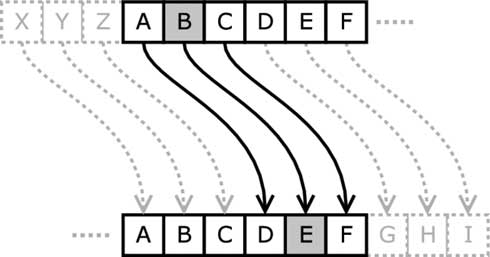
The Caesar cipher uses a method of substitution – where you are replacing a letter with one of a fixed position further down the alphabet.
EncryptionEncryption (and its opposite – decryption) is a popular study in the field of cryptology. Encryption works by applying a large mathematical pattern to a set of data and coding it so that it appears incomprehensible to anyone who does not have the decryption method, otherwise known as the key.Hard disk encryption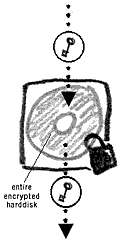
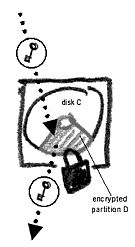
You can set your email program (e.g. Thunderbird) to store all files on the encrypted partition. Only you, or the bearer of your password, will be able to access the email on this partition. You can also encrypt your entire USB memory card or other removable devices. This is very useful if you are constantly travelling and have all your documents on the memory card. Some software (True Crypt, CompuSec) can encrypt your USB card, so that you will not need the program to be installed on every computer you wish to use with the memory card. Public Key EncryptionTraditional methods of encrypting the information you wanted to share with another person required you to give them the password to decrypt it. This was not a very secure method, as it was possible to compromise your password in the process. To get around this problem, mathematicians developed public key encryption (PKE). It is the most common method of encrypting communications (e.g. Email) today.When using PKE, your key will be made up of two parts: a public and a private key. Together they will make up your key pair. The keys are intertwined and what you encrypt with one, you can decrypt with the other. This is an integral part of PKE and a basis for its security and fallibility. You share your public key with anyone you want to communicate with. You can also upload your public key to a key server on the Internet. The private key is kept secret on your computer or floppy disk and additionally protected with a password that only you should know. Do not share your private key with anyone. If you think that your password has become compromised (stolen) then you will need to revoke your key pair and recreate them from scratch. Encrypting and decrypting a message30In the PKE system, messages are encrypted for sending to us using our public key, and we decrypt them using our private key. People obtain your public key when they wish to send you an encrypted message by asking you for it or finding one you left previously on an Internet key server.Example: You have a message that you wish to send to me encrypted. First, I must give you a copy of my public key. You use this public key to encrypt the message and send it back by email or other means. Only I will be able to decrypt this message since only I have the missing link – my private key. 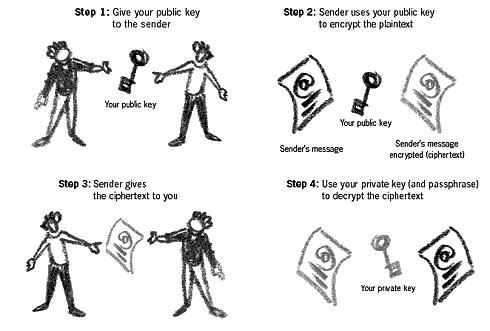
Note: by “plaintext” we refer to the original message and “cipher text” refers to the message once it has been encrypted.
This facilitates communication of encrypted messages without having to share a password and dramatically increases the security and practicality of your communications. PKE has been applied to email, Internet chat, web browsing and many other Internet services. Its security has caused controversy with many governments. The level of privacy offered by the successful application of this system has made many surveillance and intelligence agencies very worried.
Key SecurityThe reliability of the encryption depends on :
The PKE infrastructure relies on the valid identity of the public and private key. When you are encrypting a message to me using my public key, you want to be sure that this key belongs to me. Let’s have a look at the properties of a key pair. A key pair is identified by 5 distinct features:
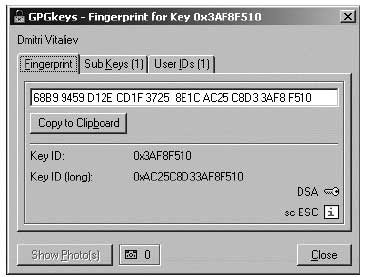
Fingerprint as seen in the GPGshell program Try and verify the above details before using someone’s public key to communicate with them. Since public key encryption does not require you to share a password with the message recipient, it is important that you can validate the true identity of the public key. Public keys are easy to create but the identifying features can also be falsified. That is why you should authenticate the person’s public key before you use it (see ‘Digital signatures’ below). Once you have established that the public key belongs to them, you can ‘sign’ it. This will tell the program that you trust the key’s validity and wish to use it.31 The key size is usually 2048 bits. This level of encryption is assumed to be far more complex than modern computers can break32.Digital SignaturesWe need the ability to verify the authenticity of our messages. This can be done by a digital signature, which also uses PKE to function. When you digitally sign a message, you include in it a unique mathematical calculation derived from its size, date and specific content. This digest is then encrypted with your private key so that the recipient can verify its validity. Once decrypted, the original digest in the signature is checked against the file received and confirms whether the file has been modified or not since it was signed. It is virtually impossible to change the content of your message without invalidating the signature. 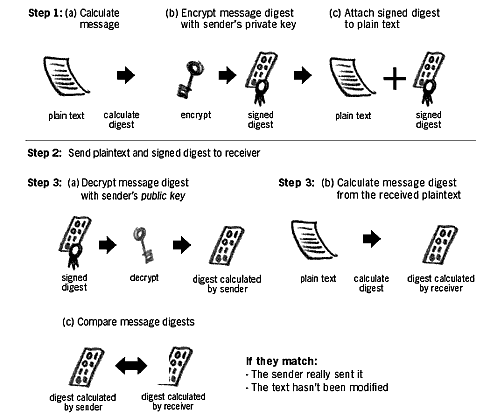
It is advisable to encrypt all your communications once you and your contacts have set up and began using PKI. This counteracts the possibility of arousing suspicion of a lone encrypted email, containing sensitive information. To sum it all up, using encryption is really not so difficult with modern software at hand. The main points to remember:
Encryption InsecurityThe biggest problem with using encryption is that it sometimes gives the user a false sense of security. Just because you are using encryption does not mean that your messages will remain 100% secure. It is, of course, an excellent method of raising your level of security, but it is not foolproof. The main problem with PKE security is the human factor: mistakes that we make by carelessness or ignorance. I will discuss three methods of breaking your encryption privacy.
Choose encryption programs that have been publicly verified to have no back doors (such as PGP, GnuPG, TrueCrypt). Be aware of your local legislation and whether it allows you to use encryption and if yes, at what level of complexity (key size). You should also understand that the current legislation in your country may oblige you to reveal your password to the authorities. Try to find out if there are any legislative privacy safeguards which you can use to prevent this from happening. There exist several other methods of breaking public key security. Your computer could have a compromised hardware that will leak your passwords and the content they protect to the intruder. There is nothing that can be done about this. The conclusion is not to rely fully on encryption. Use it to increase your security but do not operate under the impression that PKE is unbreakable. No one in the physical world is 100% secure and this is also true in the digital domain.
28
29
30
31 32 See this article http://www.keylength.com/en/3/ for a description of current and future key length necessities
33
34
35 |
